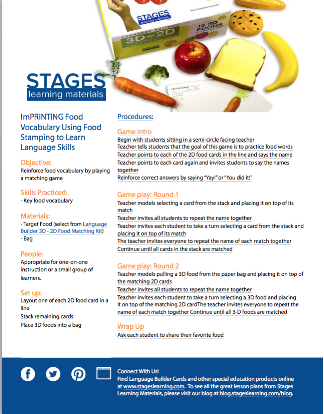Lesson Plan: ImPRINTING Food Vocabulary to Learn Language Skills
Lesson Overview
Create an art print to reinforce food vocabulary and encourage tactile exploration.
Skills Practiced
- Key Food Vocabulary
- Tactile Sensory Processing
- Fine Motor Skills
Materials
-
Target Food (select from apple, banana, broccoli, carrots, corn, orange, bread or cookie)
-
Paper Bag (or Cloth Sack)
-
Washable Paint
-
18” x 24” Construction Paper
-
Smock
-
Paper Plate (or Reusable Container)
People
Appropriate for one-on-one instruction or a small group of learners
Setup
Part I (Floor)
Layout one of each 2D food card in a line
Create a stack with the remaining 8 2D food cards
Place one of each 3D food item into the sack (note: the remaining 3D foods will not be used)
Part II (Table)
Fill paper plate with approximately ¼ of an inch of paint (one per student)
Cut the target food in half and place on new plate next to paint (one per student)
Write student name(s) on back of paper
Layout paper for demo and for student(s)
Procedures
Part I - Matching Game
Begin with students sitting in a semi-circle facing teacher
Teacher tells students that the goal of this game is to practice food words
Teacher points to each of the 2D food cards in the line and says the name
Teacher points to each card again and invites students to say the names together
Reinforce correct answers by saying “Yay!” or “You did it!”
Teacher models selecting a card from the stack and placing it on top of its match
Teacher invites all students to repeat the name together
Teacher invites each student to take a turn selecting a card from the stack and placing it on top of its match
Each time teacher invites everyone to repeat the name of each match together
Reinforce correct answers by saying “Yay!” or “You did it!”
Teacher models pulling a 3D food from the paper bag and placing it on top of the matching 2D cards
Teacher invites all students to repeat the name together
Teacher invites each student to take a turn selecting a 3D food and placing it on top of the matching 2D card
Each time teacher invites everyone to repeat the name of each match together
Reinforce correct answers by saying “Yay!” or “You did it!”
Teacher congratulates students for successfully recognizing foods and saying their names
Teacher tells students that the food of the day is (select target food)
Teacher introduces a special surprise: the art project
Before transitioning to table teacher reminds students of rules for painting
Part II - Art Project
Teacher shows students target food of the day (uncut)
Teacher invites students to repeat the name together
Teacher slices food in front of students
Teacher explains the new art word “printmaking”
Teacher models stamping paper with food and making a mistake by wiggling the food on the paper while stamping and points out that this makes it hard to see the original shape of the food (the teacher says the food word while stamping)
Teacher models stamping correctly (no wiggling) and fills up page with stamps marks that do not touch
Teacher emphasizes that all art is good art and that it is wonderful if the students’ art is different from the model
Teacher pulls out pre-cut food stamp for each student
Teacher invites students to create art using the printmaking stamp technique
Teacher encourages student to say the vocabulary word each time they stamp their paper
Tips and Variations
Tactile Senses: Some students will NOT want to touch the food stamps with bare hands. Have plastic gloves ready. Some students will not want to feel the texture of the food even through the gloves. Use a corn holder or fork to create a solid handle for that student to hold. While modeling, rejoice and verbalize the texture of what you are holding. Some students will be inspired to bravely touch things if they see others (teacher and peers) doing it.
Pre-Cutting Stamps: Different foods will require different approaches for stamping. Most items will be successful when cut in half. Some may work better in quarters or slices. Consider sticking with fruits and vegetables that are easier to use as stamps.. Create a sample with each stamp before attempting with students.
Easy Clean-Up: Although tempting, covering the table with newspaper may create sensory overload for some students. For easier cleanup, give each student a tray to work on.
Building on Learning: Play this game every day until each food card has been featured. Each time use a new color to stamp, but stamp on top of the same piece of art to create one beautiful piece of art that serves as a reminder for each food. Expand food vocabulary further using the Lang-O-Learn Food Cards.
Reinforcing Learning: Hang student art on the wall with the matching 2D food card. Take pictures of the students completing this activity and hang them with the art as a reminder.
Social Skills: If working with a group, ask students to look at other student stamp pictures and make a positive comment while naming the fruit, vegetable etc.

Lucia Berliner
Lucia Berliner has over a decade of experience as an educator in both formal and informal settings. She has previously worked as an elementary school art teacher at one of Michelle Obama's Turnaround Art Schools, developed after school and summer programs, and interned as an art therapist for children with exceptionalities. Lucia has a fondness for working with children with autism, as she comes from a family with multiple people on the spectrum. She has a teaching certificate in early childhood education and is currently pursuing her Masters of Education in Specialized Studies at the Harvard Graduate School of Education.






